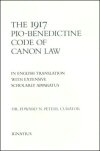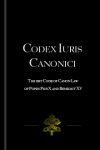The 1917 Code of Canon Law in English & Latin (2 vols.)
Digital Logos Edition
Overview
The 1917 Code of Canon Law is a landmark of canonical jurisprudence that remains indispensable for understanding the current form of the Latin-Rite Catholic Church. The drafters of the 1917 Code condensed and reconciled decrees, decretals, precedent and procedural developments that had accumulated over centuries into a single code that touched on all aspects of the visible Church. This most important code is fundamental to understanding the decrees of the Second Vatican Council and is the foundation for the 1983 Code, which, along with Catechism of the Catholic Church, are the most important ecclesiastical documents promulgated since the Council of Trent in the sixteenth century.
The Logos edition ties the canons into the rest of your Logos library seamlessly. References to these canons will appear on mouseover in the reference texts in your library, allowing you to see the exact citation without losing your place. Read the Latin and the English side-by-side and use the dictionary look-up tool to investigate English or Latin words and concepts. Logos brings your studies on canon law further than ever.
This is a two-volume collection containing the English and Latin editions of the 1917 Code of Canon Law. We also sell commentaries on the same text. Click here to find out more.
- The official English translation by one of the world’s leading experts on canon law
- The original Latin edition from the first publication in 1918
- Title: The 1917 Code of Canon Law in English & Latin
- Publishers: Ignatius Press, P. J. Kenedy & Sons
- Volumes: 2
- Pages: 1,557
This title is included in the following collections
You can save when you purchase this product as part of a collection.
Verbum 10 Académico (Español)
$829.99$829.99Verbum 8 Gold Legacy Library
$849.99$849.99Verbum 7 Gold Legacy Library
$849.99$849.99Verbum 9 Gold Legacy Library
$849.99$849.99
- $1,099.99
- $1,499.99
- $1,499.99
- $1,499.99
- $1,699.99
- $2,499.99
- $2,999.99
- $2,999.99
- $2,999.99
- $3,999.99
- $4,749.99
- $4,749.99
- $4,749.99
- $7,749.99
- $7,749.99
- $21,749.99
- $24,999.99

1917 Pio-Benedictine Code of Canon Law
- Editor: Edward N. Peters
- Publisher: Ignatius Press
- Publication Date: 2001
- Pages: 777
Available for the first time in a comprehensive English translation, this thoroughly annotated yet easy-to-use presentation of the classic 1917 Code of Canon Law by canon and civil lawyer Dr. Edward Peters is destined to become the standard reference work on this milestone of Church law. More than just of historical interest, the 1917 Code is an indispensable tool for understanding the current 1983 Code under which the Roman Catholic Church governs itself.
Dr. Peters’ faithful translation of the original Latin text of 1917, along with his detailed references to such key canonical works as Canon Law Digest and hundreds of English-language doctoral dissertations on canon law produced at the world’s great Catholic universities, now allows researchers direct access to this great fountain of ecclesiastical legal science. No student of canon law, and indeed, no one with a need to understand modern Church administration, can afford to be without this important volume.
Edward N. Peters holds the Edmund Cardinal Szoka Chair at Sacred Heart Major Seminary in Detroit. He has attended Saint Louis University, the University of Missouri at Columbia School of Law, and the Catholic University of America, attaining degrees in political science, law, and canon law. He has served as judge, as special assistant to the bishop, and as university professor. In 2010, Peters was named a Referendary of the Apostolic Signatura by Pope Benedict XVI.

The 1917 Pio-Benedictine Code of Canon Law of the Catholic Church is the completely developed legal system for the Catholic Church and the Vatican, which was in effect from 1917 until 1983. After the First Vatican Council, Pope Pius X and his clergy began collecting and canonizing the ancient collections of canon laws, which included Pope Gregory IX’s Liber Extra from 1234, Pope Boniface VIII’s Liber Sextus from 1298, and Pope John XII’s Clementines from 1317. Pope Pius X and his clergy synthesized these documents into a single systematic canonical code, which became the Codex Iuris Canonici, or, the 1917 Code of Canon Law. In 1918, the code came into effect under Pope Benedict XV. The 1917 Code of Canon Law was replaced in 1983 when Pope John XXIII and Pope John Paul II brought the 1983 Canon Law out of the Second Vatican Council, canons which are still in use today. This is the Codex in its original Latin.
Reviews
2 ratings

Ordice Gallups, Obl.S.B.
8/24/2018
Shawn Tunink
10/30/2013
Every canon law student needs logos for an electronic copy of the code. The link to the 1917 code are all built in and ready to go. We've just go to get this package funded.